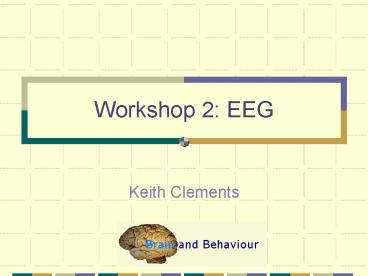Workshop 2: EEG - PowerPoint PPT Presentation
1 / 11
Title:
Workshop 2: EEG
Description:
Trait anger associated with increased left frontal activity (Harmon-Jones & Allen, 1998) ... Anger and frontal brain activity: EEG asymmetry consistent with approach ... – PowerPoint PPT presentation
Number of Views:242
Avg rating:3.0/5.0
Title: Workshop 2: EEG
1
Workshop 2 EEG
- Keith Clements
2
The Electroencephalogram
- Rhythmic voltage changes recorded from the scalp
surface. - Generated by synchronised activity of large
numbers of neurons. - Traditionally divided into different bands
- Delta 0.5-4 Hz
- Theta 4-8 Hz
- Alpha 8-13 Hz
- Beta 13-30 Hz
- Gamma 30-50 Hz
3
Sources
- Not generated by action potentials? High
frequencies are poorly conducted. - Mainly thought to reflect synaptic potentials
- Alpha produced by thalamo-cortical links,
generated by the thalamus.
4
Technicalities
- Low voltage signal. Good electrical contact is
essential - Recording may be bipolar (between two active
sites) or monopolar (using a neutral reference
site). - Sources of artifact
- 50Hz hum
- Muscle potentials
- Eye movements
5
Alpha
- Around 70 of EEG activity
- Alpha blocking referred to as desynchronisation.
- Typically attenuated when the eyes are open
6
Applications
- Sleep stages
- Distinct changes in the EEG during sleep
7
Applications
- Hemispheric differences e.g. Davidson et al
(1990) found that positive emotions were
associated with activation of frontal areas of
the left hemisphere, while disgust was associated
with right hemisphere activation. - Depression associated with reduced activity
(increased alpha) in the left frontal lobe
(Henriques Davidson, 1990). - Valence or approach/avoidance?
- Trait anger associated with increased left
frontal activity (Harmon-Jones Allen, 1998)
8
The workshop
- Well be recording EEG using bipolar leads from
the occipital lobe. - Well record during three states relaxed eyes
closed, relaxed eyes open and during mental
arithmetic. - The signal will be filtered to separate activity
in each of four bands (delta, theta, alpha
beta) - As well as standard deviation, as a measure of
amplitude, we will also measure frequency,
calculated from the length of one cycle during
the initial segment.
9
SD x 4
SD x 4
SD x 4
10
One cycle, gives frequency. Zoom in as needed for
different bands. Repeat three times to allow you
to work out an average frequency.
11
References
- Davidson, RJ. et al. (1990). Approach/withdrawal
and cerebral asymmetry Emotional expression and
brain physiology. Journal of Personality Social
Psychology, 58, 330-341 - Harmon-Jones, E. Allen, J.J.B. (1998). Anger
and frontal brain activity EEG asymmetry
consistent with approach motivation despite
negative affective valence. Journal of
Personality Social Psychology 74, 1310-1316. - Henriques J.B. Davidson, , R.J. (1990).
Regional brain electrical asymmetries
discriminate between previously depressed and
healthy control subjects. Journal of Abnormal
Psychology, 99, 22-31.































